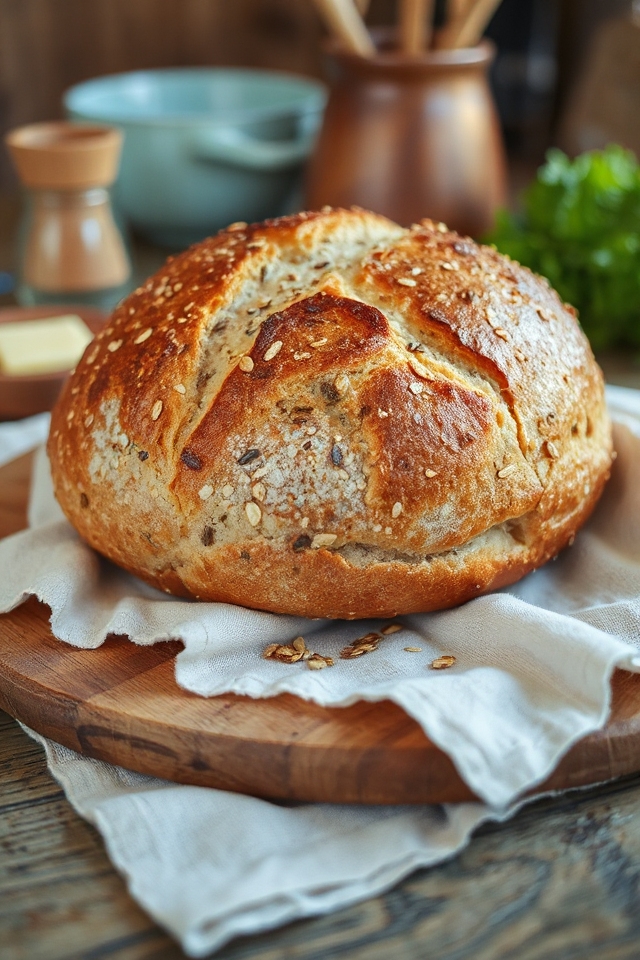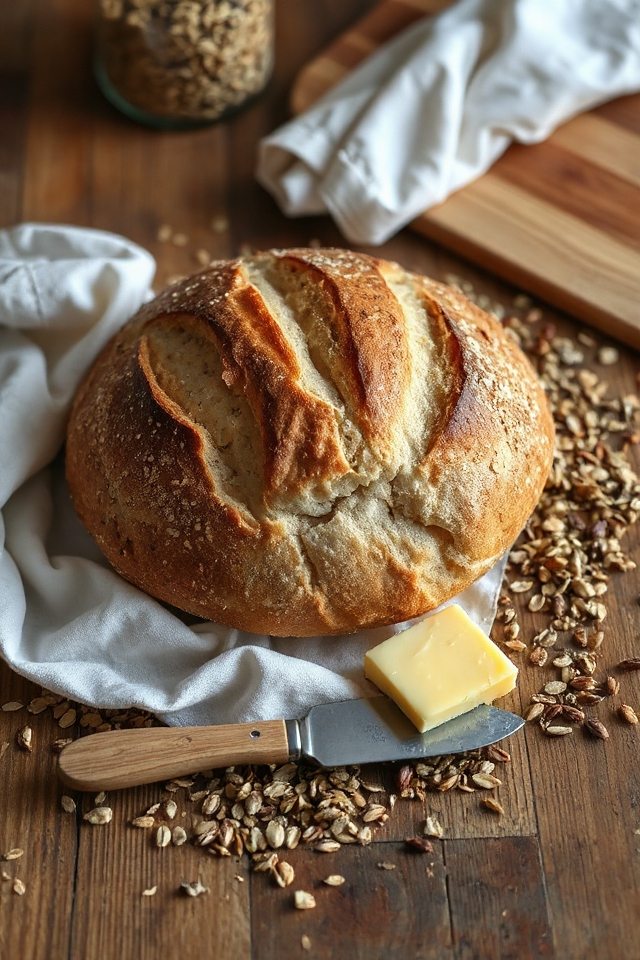Why You’ll Love This Soaked Multigrain Sourdough Bread Recipe
You’re going to love this soaked multigrain sourdough bread recipe for its incredible flavor and nutrition. The combination of grains not only adds depth but also boosts the bread’s nutritional value.
I find that soaking the grains enhances their digestibility, making each slice satisfying yet light. The tangy notes from the sourdough starter elevate the taste, making it perfect for sandwiches or simply toasted with butter.
Plus, the aroma while it bakes fills my kitchen with warmth and comfort. Trust me, once you try this bread, you’ll wonder how you ever lived without it in your life!
Ingredients of Soaked Multigrain Sourdough Bread
Making soaked multigrain sourdough bread isn’t just a baking project; it’s a delightful adventure that fills your kitchen with the kind of cozy aroma that makes you feel right at home.
Before we roll up our sleeves and plunge into the mixing bowl, let’s get our ingredients sorted out. There’s something so satisfying about having everything prepped and ready to go, kind of like laying out your paint before starting a masterpiece. Trust me, it makes the whole process smoother, and you won’t end up in a floury panic halfway through.
Here’s what you’ll need to whip up this delicious loaf:
- 2 cups proofed sourdough starter
- 3/4 cup harvest grain blend for bread
- 2 tablespoons butter or olive oil
- 1/2 cup milk
- 1 teaspoon salt
- 1/4 cup honey
- 2 cups multi-grain flour
- 1 cup whole wheat flour
- 1/2-1 cup all-purpose flour (as needed)
- Additional harvest grain blend for sprinkling on top of the loaf (optional)
Now, before you dash off to the grocery store, let’s chat about a few things. The proofed sourdough starter is your secret weapon here, so make sure it’s nice and bubbly.
If you don’t have a starter on hand, no worries—just give yourself some time to prepare one, and you’ll be golden. The harvest grain blend can be a mix of various grains, like oats, flaxseeds, or even seeds you love. Feel free to customize it to suit your taste or what you have on hand.
And remember, the honey adds a touch of sweetness, balancing out the tangy notes of the sourdough. If you’re feeling adventurous, you could even swap it for maple syrup or agave for a different flavor twist. Just imagine the possibilities, right? Happy baking!
How to Make Soaked Multigrain Sourdough Bread

Now, here comes the fun part: folding the dough. Think of it as giving your dough a gentle hug—fold it like a letter three times, turning it 90 degrees between each fold.
After that, transfer your dough to a lightly oiled bowl, making sure to coat it well. Cover it and let it hang out in the fridge for 6-8 hours. If time is tight, you can skip this step, but just know that a little extra cold rest can make for a better-flavored bread.
When you’re ready, shape your dough into a loaf and place it in a greased loaf pan (or on a cookie sheet if you’re feeling fancy). Let it rise until it’s doubled in size, which takes about 3 hours. If you want to sprinkle some more of that harvest grain blend on top, give it a light mist of water first.
When it’s puffed up and looking good, slash the top a few times to let the steam escape, then pop it in the oven at 375 degrees F for 40 to 50 minutes. The aroma that fills your home will be nothing short of heavenly, and when you pull that golden loaf out, it’ll feel like you’ve created a masterpiece.
Enjoy your warm, crusty delight, maybe with a little butter, and bask in the glory of your baking skills.
Soaked Multigrain Sourdough Bread Substitutions & Variations
When you’re looking to mix things up with your soaked multigrain sourdough bread, several substitutions and variations can elevate your creation.
I often swap out the butter for coconut oil for a dairy-free option. If you want a nuttier flavor, try adding chopped nuts or seeds to the dough.
For a sweeter twist, you can replace the honey with maple syrup. You might also experiment with different flour blends, like rye or spelt, to change the texture and taste.
Finally, consider adding herbs or spices, like rosemary or cinnamon, for a unique twist that’ll surprise your taste buds!
Additional Tips & Notes
Although baking sourdough bread can seem intimidating, a few key tips can help guarantee your multigrain loaf turns out perfectly every time.
First, always confirm your starter is active and bubbly; this makes a huge difference in flavor and texture.
Don’t rush the rising process—patience is key! If your dough feels too sticky, don’t hesitate to add more flour gradually.
I also recommend using a kitchen scale for precise measurements, which can improve consistency.
Finally, experiment with different grain blends to find your favorite mix.
Trust your instincts, and enjoy the journey of sourdough baking!
